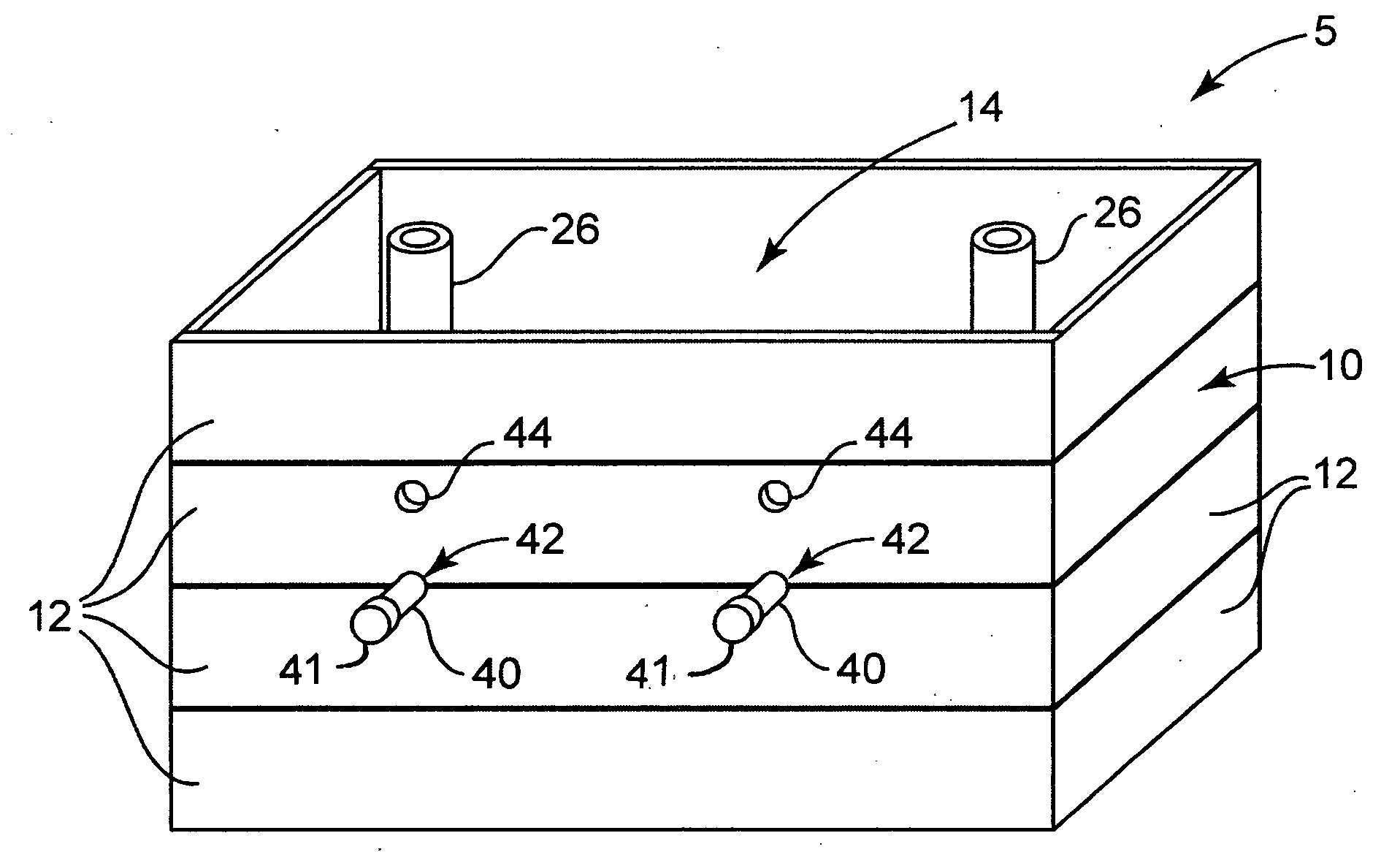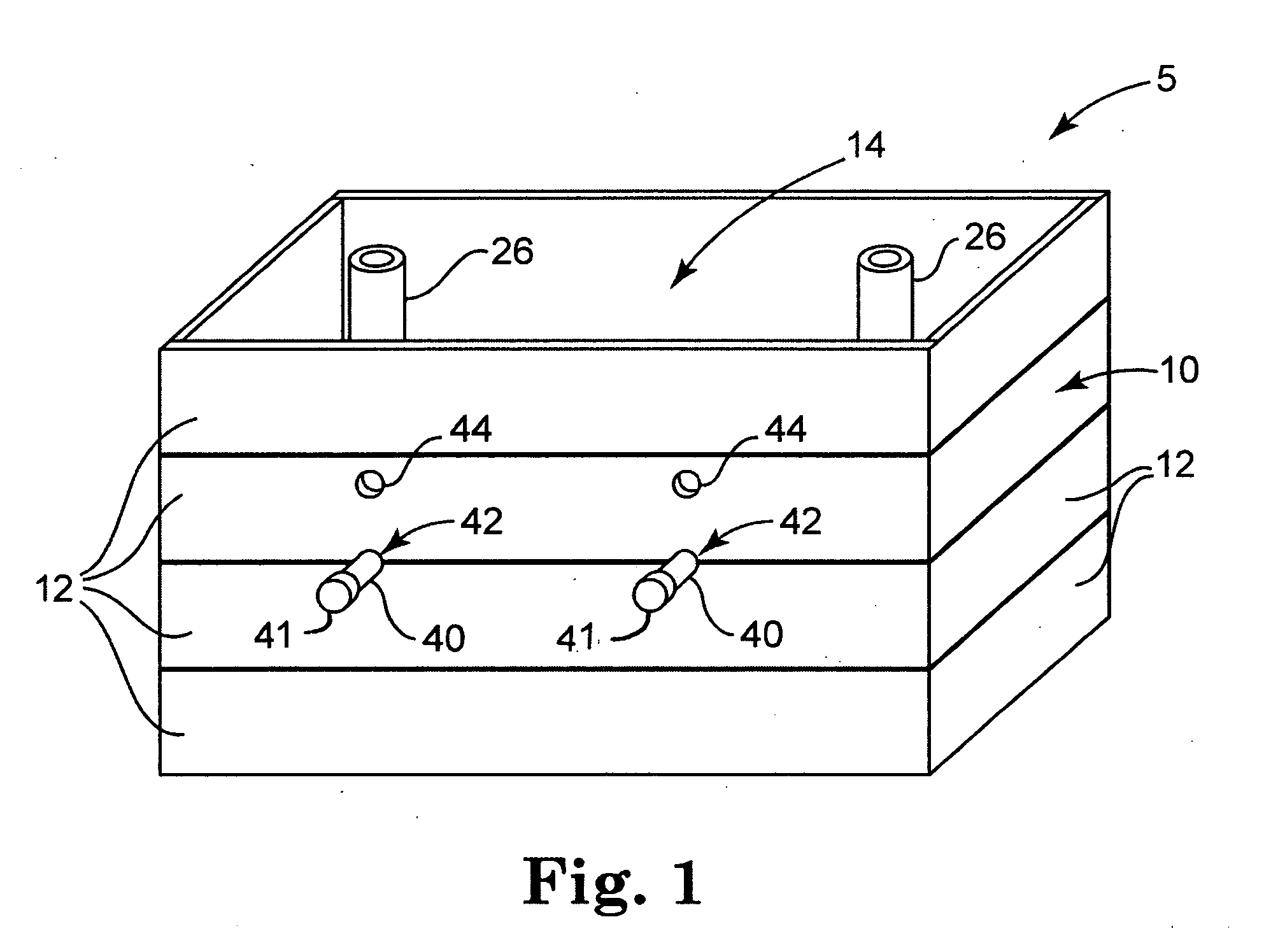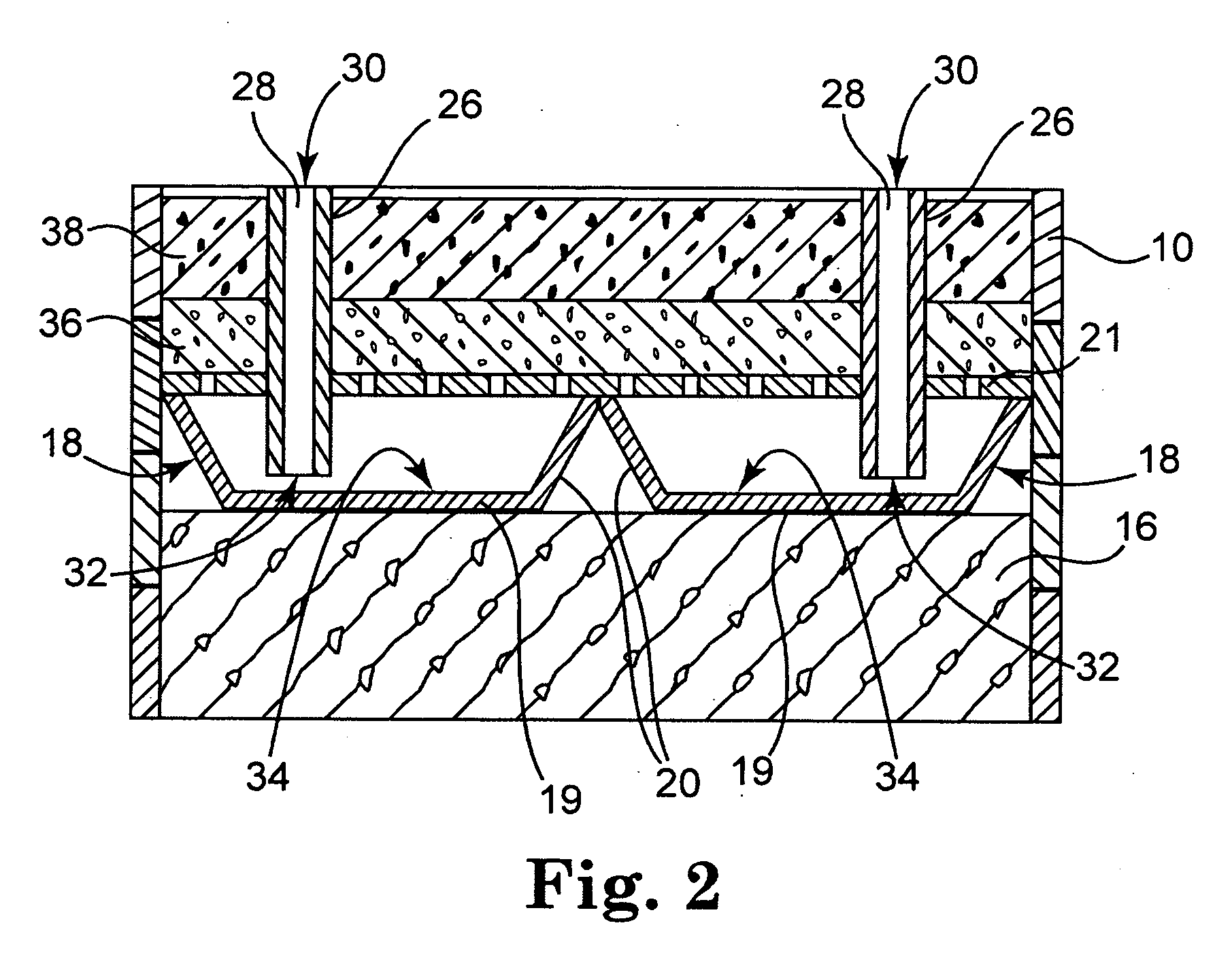[0008]The present invention provides certain advantages over prior garden or planter systems or devices. One
advantage of the present invention is the planter system includes a bed for planting that is elevated to a desired height, allowing a person to garden without having to bend, stoop or kneel. Yet another
advantage is that the system includes at least one water retaining vessel (i.e., reservoir, or
storage area) under the bed that stores water and provides water to plants in the bed over an extended period of time. Thus, the system of the present invention does not require frequent watering. A further
advantage is that the planter system includes a fill tube by which to easily fill the at least one water retaining vessel that extends out from the top of the system, or above the bed. In addition, filling water retaining vessels through the fill tubes eliminates the need to pour water directly onto the top surface of the bed that preferably comprises a
dirt mixture, which could cause
dirt to splash onto nearby items. Further, at least one drain
pipe may be provided in communication with the at least one water retaining vessel, which allows for the water retaining vessel to be drained as desired for cleaning purposes, for example. Additionally, the system includes at least one weeping hole in communication with the upper portion of the at least one water retaining vessel through which
excess water may flow out of the system. Therefore, the system is able to hold a desired or predetermined amount of water, without an excess of water being retained. Still another advantage of the planter system is that it is modifiable, such that it may be enlarged in size to accommodate more plants, for example.
[0009]One aspect of the present invention is a planter system. One embodiment of the planter system comprises: at least one water retaining vessel; a
bedding material layer disposed above the at least one water retaining vessel; a structure surrounding the at least one water retaining vessel and the bedding material layer; and at least one fill tube extending from above the bedding material layer, through the bedding material layer, and into the at least one water retaining vessel, through which water is supplied to the at least one water retaining vessel to a predetermined level. The planter system may further comprise at least one
weep hole through the structure and in communication with the at least one water retaining vessel, wherein water supplied to the at least one water retaining vessel in excess of the predetermined level is able to flow out of the system. The planter system may further comprise a grate disposed between the bedding material layer and the at least one water retaining vessel in order to prevent bedding material from entering the at least one water retaining vessel while allowing water to enter the bedding material layer. The planter system may further comprise a support layer disposed below the at least one water retaining vessel, on order to support the at least one water retaining vessel. The structure may surround at least portion of the support layer. The bedding material layer may comprise first and second
layers, wherein the first layer comprises a material to support the second layer and the second layer comprises a
dirt mixture and is disposed above the first layer. The at least one water retaining vessel may comprise a drain through the structure and in communication with the at least one water retaining vessel, in order to drain water out of the at least one water retaining vessel and out of the system.
[0010]A second embodiment of the planter system comprises: a support layer; at least one water retaining vessel disposed above at least a portion of the support layer; a grate disposed above the at least one water retaining vessel and the support layer; a bedding material layer disposed above the grate; at least one fill tube extending between from above the bedding material layer to within each of the at least one water retaining vessels, through which water is supplied to the at least one water retaining vessel to a predetermined level; and a structure surrounding the support layer, the at least one water retaining vessel, the grate, and the bedding material layer. The planter system may further comprise at least one
weep hole through the structure and in communication with the at least one water retaining vessel, wherein water supplied to the at least one water retaining vessel in excess of the predetermined level is able to flow out of the system. The bedding material layer may comprise first and second
layers, wherein the first layer comprises a material to support the second layer and the second layer comprises a dirt mixture and is disposed above the first layer. The at least one water retaining vessel may comprise a drain through the structure and in communication with the at least one water retaining vessel, in order to drain water out of the at least one water retaining vessel and out of the system.
[0011]A second aspect of the present invention is a method of making a planter system having an elevated bedding material layer. One embodiment of the method comprises the steps of: providing a structure comprising a plurality of sidewalls, a top portion and a bottom portion, wherein the sidewalls form an
interior space, and the top portion is open; positioning the structure on the ground; providing a support material in the
interior space; placing at least one water retaining vessel in the
interior space above the support material; inserting a grate in the interior space that is disposed above the at least one water retaining vessel, wherein the grate comprises openings allowing water to pass there through; providing a bedding material that is disposed above the grate, wherein the grate prevents the bedding material from entering the at least one water retaining vessel and the bedding material allows water to move through and plants to grow therein; and positioning at least one fill tube such that the at least one fill tube extends from the open top portion of the structure, through the bedding material and the grate and into the at least one water retaining vessel, such that water may be added to the at least one water retaining vessel through the fill tube from above the top portion. The bottom of the structure may be open. The method may further comprise, before the positioning the structure on the ground step, the steps of: digging a trench in the ground; and filling the trench with a support material; and wherein, in the positioning the structure on the ground step, the structure is positioned over the trench in the ground. The method may further comprise the step of forming at least one
weep hole through the structure and in communication with the at least one water retaining vessel, wherein water supplied to the at least one water retaining vessel in excess of a predetermined level is able to flow out of the system. The bedding material layer may comprise first and second
layers, wherein the first layer comprises a material to support the second layer and the second layer comprises a dirt mixture and is disposed above the first layer. The method may further comprise the step of forming at least one drain hole through the structure, wherein the at least one water retaining vessel is in communication with the at least one of the drain hole, in order to allow water to be drained out of the at least one water retaining vessel and out of the system. The support material may be provided having a certain depth in order to elevate the bedding material layer to a predetermined height. The method may further comprise the step of modifying the structure in order to change the size or shape of the interior space.
 Login to View More
Login to View More  Login to View More
Login to View More 


